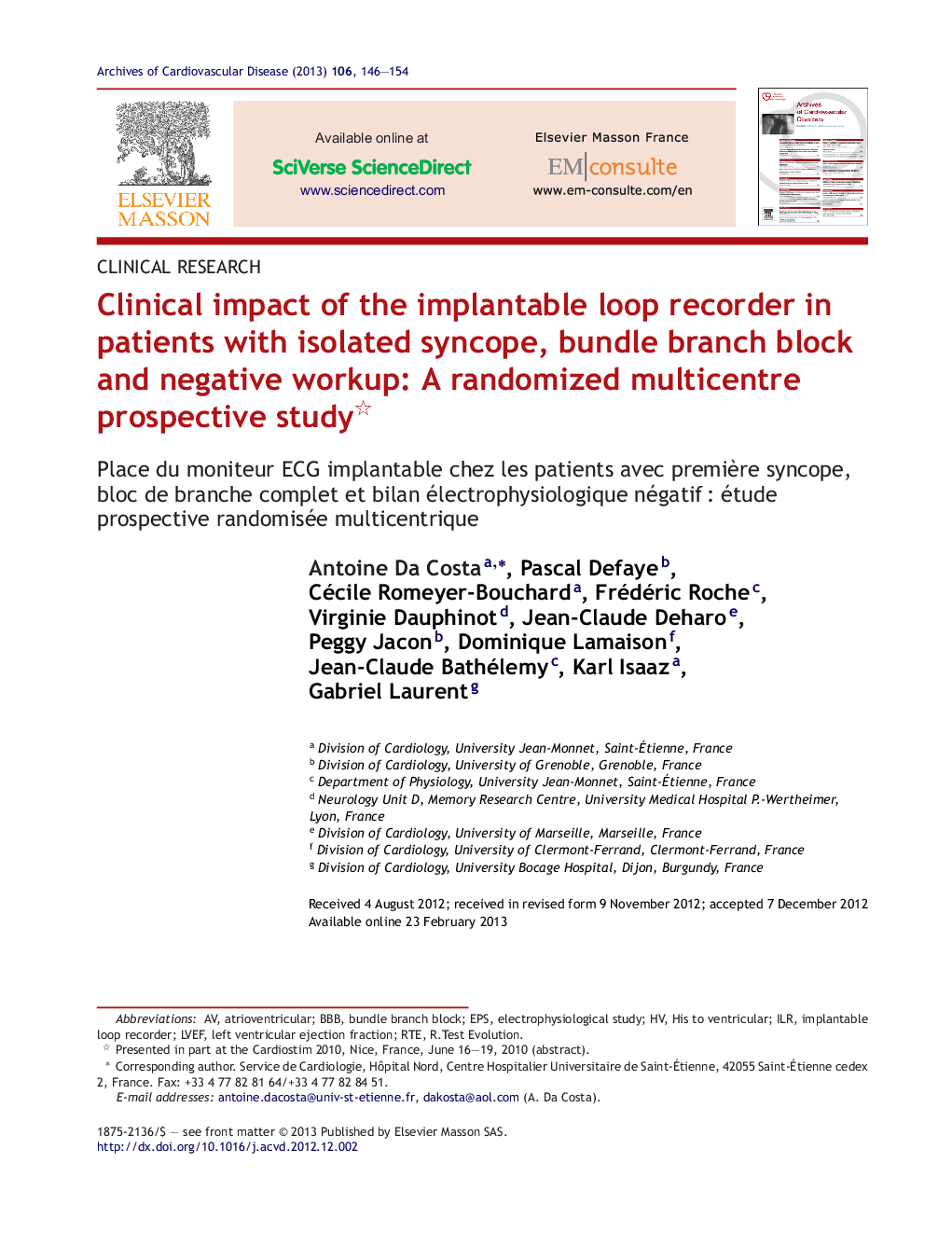| کد مقاله | کد نشریه | سال انتشار | مقاله انگلیسی | نسخه تمام متن |
|---|---|---|---|---|
| 2889086 | 1574366 | 2013 | 9 صفحه PDF | دانلود رایگان |

SummaryBackgroundFew studies have compared conventional testing with prolonged monitoring using an implantable loop recorder (ILR) following the first syncope episode in patients with bundle branch block (BBB) and negative workup.ObjectivesTo compare two syncope evaluation strategies–primary use of an ILR (Group 1) versus conventional testing (Group 2)–and to estimate the prevalence of significant arrhythmias in the ILR patient subset.MethodsFrom January 2005 to December 2010, 78 patients admitted after one syncope episode were randomized to ILR (n = 41) or conventional follow-up (n = 37). Mean follow-up was 27 ± 12 months.ResultsMean age was 76 ± 8 years and 30 patients were women (38.5%); 18 presented cardiomyopathy (23%) and 12 had a history of atrial fibrillation (15.4%). Mean left ventricular ejection fraction was 56.5 ± 11% and mean His-to-ventricle interval was 55 ± 6 ms based on negative electrophysiological study (EPS). Electrocardiogram abnormalities involved: 34 left bundle branch blocks (BBBs); 11 right BBBs; and 33 bifascicular blocks. Overall, 21 patients (27%) developed significant arrhythmic events: ventricular tachycardia (n = 1; 1.3%); sudden death (n = 2; 2.6%); third-degree atrioventricular (AV) block (n = 14; 18%); sick sinus syndrome (n = 4; 5.1%). In 19 (24.4%) patients, relevant arrhythmias were detected, with a significant difference between the ILR group (n = 15/41; 36.6%) and the conventional follow-up group (n = 4/37; 10.8%) (P = 0.02). Eighteen patients were implanted with pacemakers; one received an implantable defibrillator. No predictors of AV block were identified in the ILR group.ConclusionsIn this randomized prospective study, the ILR strategy proved largely superior to conventional follow-up in detecting recurrent events, with a potential impact on therapeutic management. This observation highlights the usefulness of early monitoring in patients with BBB and negative EPS even after the first syncope episode but an empiric pacemaker strategy remains to be validated in this selected population.
RésuméContexteLes données publiées sur le mécanisme des syncopes isolées chez les patients avec bloc de branche complet (BBC) et bilan électrophysiologique négatif sont peu nombreuses.ObjectifsDe comparer pour les patients avec première syncope et BBC une stratégie avec mise en place d’un moniteur ECG implantable (MEI) (Group I) versus un suivi conventionnel clinique et holter (Group II).MéthodesDe janvier 2005 à décembre 2010, 78 patients (76 ± 8 ans) ont été randomisés, 41 patients dans le groupe MEI et 37 patients dans le groupe suivi conventionnel. Le suivi moyen était de 27 ± 12 mois.RésultatsLes troubles de conduction étaient les suivants : 34 BBC gauche, 11 BBC droit et 33 blocs bifasciculaires. Dans l’ensemble de la population, 21 patients (27 %) ont développé un évènement rythmique : une TV dans un cas (1,3 %), une mort subite dans deux cas (2,6 %), un BAV du 3e degré chez 14 patients (18 %) et une dysfonction sinusale dans quatre cas (5,1 %). Pour 19 patients (24,4 %), la détection d’un évènement rythmique a été possible, avec une différence significative entre les deux groupes de suivi : MEI (n = 15/41 ; 36,6 %) versus suivi conventionnel (n = 4/37 ; 10,8 %) (p = 0,02). Par conséquent, 18 patients ont bénéficié de l’implantation d’un pacemaker et un patient de la mise en place d’un défibrillateur.ConclusionsCette étude prospective randomisée multicentrique chez des patients avec un épisode de syncope associé à un BBC et une exploration électrophysiologique négative montre que la stratégie du MEI est très largement supérieure au suivi traditionnel. Dans le groupe avec MEI, la prévalence des évènements rythmiques était de 36,6 % à 2,5 ans (14,6 % par an) versus 10,8 % (4,3 % par an) dans le groupe de suivi conventionnel.
Journal: Archives of Cardiovascular Diseases - Volume 106, Issue 3, March 2013, Pages 146–154